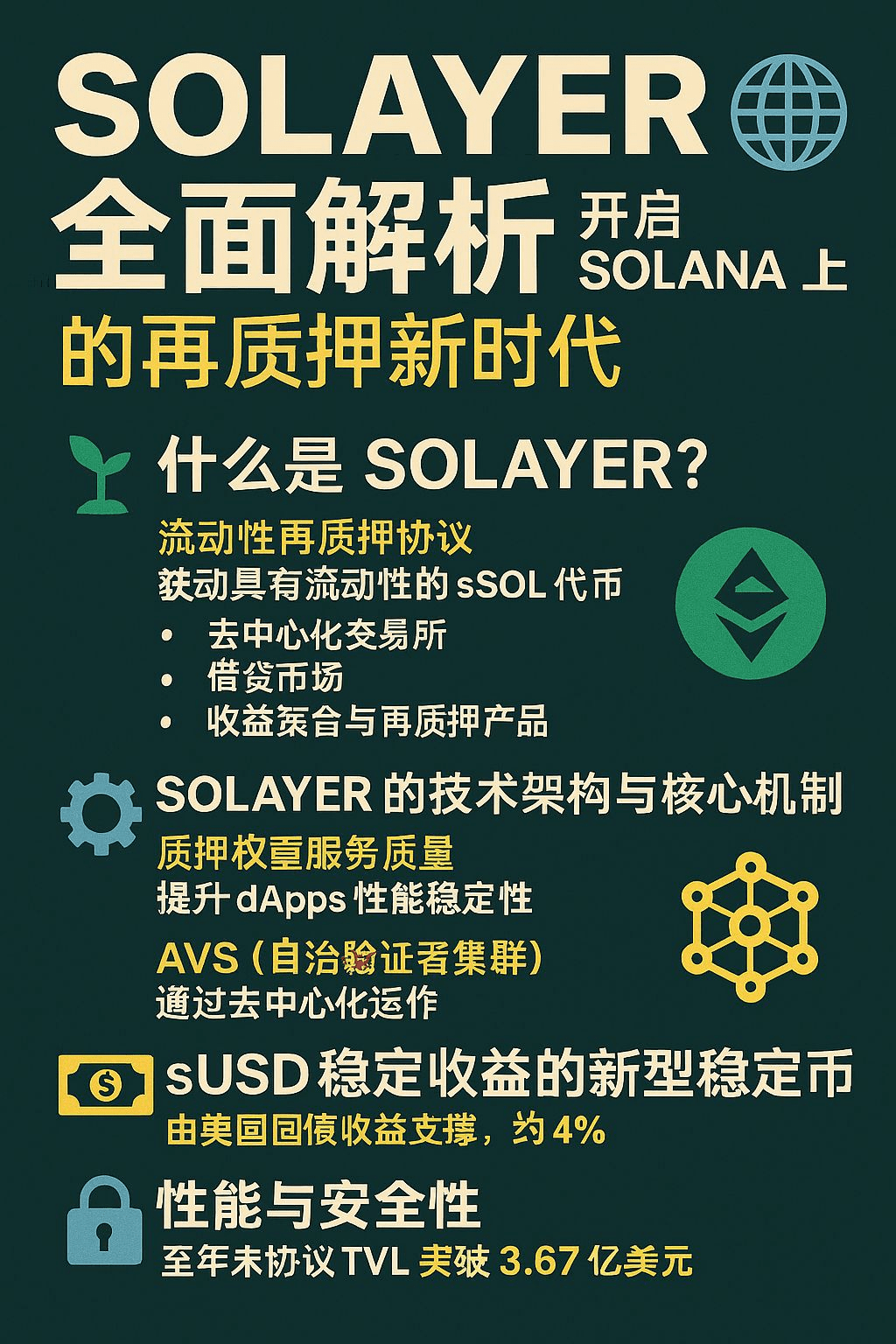In the rapid evolution of decentralized finance (DeFi), how to enhance the efficiency of staked assets and unleash more potential has always been a focus in the industry. As the first native restaking protocol in the Solana ecosystem, Solayer is providing users and institutions with new financial tools and income models through cutting-edge technology and innovative mechanisms. This article will take you deep into the core mechanism, technical architecture, product design, and future prospects of Solayer.
What is Solayer? 🌱
Solayer is a restaking protocol running on the Solana blockchain. Its core goal is to allow users to reuse already staked assets while maintaining liquidity, thereby generating additional income.
Users can deposit SOL or other compatible staking tokens into Solayer to obtain sSOL — a liquid tokenized asset. Holders of sSOL not only enjoy staking rewards but can also use it in various DeFi applications, such as:
Liquidity strategy for decentralized exchanges
Collateral in the lending market
Yield aggregation and restaking products
This way, originally locked staking assets can be released again, bringing higher capital utilization and flexibility.
Solayer's technical architecture and core mechanism ⚙️
1. Staking and restaking process
Users deposit SOL or compatible LSTs (Liquid Staking Tokens) into the protocol and receive sSOL as a certificate. The protocol's pool manager is responsible for allocating and delegating these assets to validator nodes and accurately calculating returns through the reward distribution module.
This model not only ensures staking security but also improves overall yield efficiency through optimized allocation.
2. Stake-weighted QoS (Quality of Service)
This is a core innovative mechanism of Solayer. In simple terms, certain decentralized applications (dApps) may require higher transaction confirmation priority during peak periods. Through stake-weight QoS, dApps can ensure transaction bandwidth by delegating more sSOL, thereby achieving faster confirmation speeds. This is especially important for applications that require stable performance, such as high-frequency trading or payment networks.
3. AVS (Autonomous Validator Cluster)
Solayer does not rely on a single centralized validator but achieves decentralized operation through an autonomous validator cluster. AVS automatically selects the best-performing validators to ensure the reliability and security of network operations while reducing dependence on single points of failure.
4. Flexible unbinding mechanism
Traditional staking often requires a long unbinding period, but Solayer has shortened the unbinding period to a maximum of 2 days and also offers an emergency exit mechanism to address unexpected situations. This greatly improves the liquidity and security of funds.
Solayer's compatibility and scalability 🔗
In addition to native SOL, Solayer also supports various liquid staking tokens (LSTs), such as:
Marinade-SOL (mSOL)
Jito-SOL
Blaze-SOL (bSOL)
Infinity-SOL (INF)
By converting these tokens into sSOL, users can participate in restaking and reward distribution under a unified system, avoiding the high costs of liquidity fragmentation and asset conversion. This compatibility enhances the overall liquidity and operability of the ecosystem.
sUSD — A new type of stablecoin for stable income 💵
Solayer's innovation is not limited to staking and restaking; it has also launched sUSD — a stablecoin backed by the yields of U.S. Treasury Bills (T-Bills).
Characteristics of sUSD:
Supported by real-world assets (RWA), with a yield of about 4%
Lower risk, far less volatility than cryptocurrencies
Provide stable passive income channels
This makes Solayer not just a DeFi tool but also a bridge between traditional finance and the crypto world.
Performance and Security 🔒
Solayer's rapid development is already reflected in TVL (Total Value Locked). By the end of 2024, the protocol's locked amount is expected to exceed $367 million, showing market trust in its mechanism.
In terms of security, Solayer achieves this through:
Automated validator selection
Precise reward calculation module
Flexible unbinding and emergency exit mechanism
To ensure the safety of user assets and the efficiency of operations.
Future outlook of Solayer 🚀
Solayer is not just a staking protocol on Solana but a financial-grade infrastructure. Its future development directions include:
1. Expand support for more LSTs to further enhance liquidity.
2. Optimize stake-weight QoS to provide stronger performance guarantees for dApps.
3. Promote the adoption of sUSD, becoming a core tool for stable income.
4. Collaborate with institutional investors to provide compliant and secure restaking and yield solutions.
With the continuous evolution of DeFi, Solayer is likely to become a key infrastructure in the Solana ecosystem, serving both ordinary users and institutions with high-performance and high-security needs.
Conclusion 🌟
Solayer represents the forefront exploration of the Solana restaking track. Through sSOL and sUSD, it not only addresses issues of capital liquidity and yield optimization but also brings a more stable and scalable infrastructure to DeFi.
In the future, as more users and institutions participate, Solayer is expected to become a bridge connecting traditional finance and crypto finance, allowing staked assets to truly unleash unlimited potential.
#BuiltonSolayer @Solayer $LAYER


